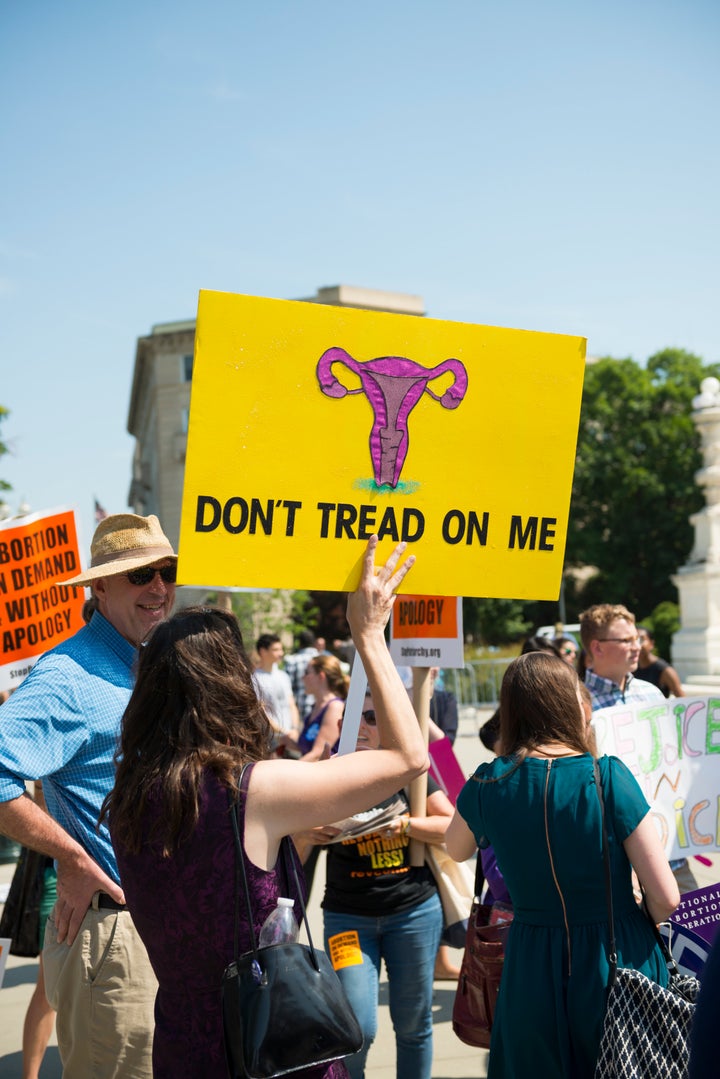
Every year, anti-abortion legislators and legislatures chip away at reproductive rights, and 2018 brought a wave of extreme restrictions from lawmakers determined to topple Roe v. Wade. This year, as of Dec. 11, 22 abortion restrictions were passed nationwide — a number that will likely edge up to 24 by the time 2019 begins.
On the surface, that number looks pretty good. It’s the fewest abortion restrictions passed in a single year in more than a decade, according to the Guttmacher Institute, which studies and promotes reproductive health policy. And for the first time in recent years, the number of proactive reproductive health policies — measures that make it easier for women to access abortion services and birth control, for example — outpaced the number of restrictions.
And yet ... the laws that legislators pushed through in 2018 and the rhetoric they used were extreme and aggressive in ways that deeply unsettled reproductive rights advocates, said Elizabeth Nash, the senior state issues manager at Guttmacher, particularly given the Supreme Court’s new conservative majority. Furthermore, new laws don’t tell the full picture as some states tried to resurrect old anti-abortion legislation with that new conservative majority mind.
“What we saw this year was a lower number of enacted restrictions,” Nash said. “But some of these are so extreme that it’s a shift in the type of restrictions we’re seeing. That’s not captured in the pure number.”
Here’s how anti-abortion legislators targeted abortion access in 2018.
They instituted restrictions that make it really hard — often impossible — for women to get abortions within a legal time frame
The most extreme abortion restriction of 2018 came out of Iowa, which banned abortion once fetal cardiac activity can be detected — at around six weeks gestation — except in cases of rape or incest or if the woman’s life is at risk.
Six weeks is so early in a pregnancy that a woman might not know she’s pregnant yet; the law bans abortion before many women even realize they’ve missed a period. And even if they know they’re pregnant before six weeks, it leaves virtually no time for them to find an abortion provider, book an appointment, come up with the money they need and tackle any of the many other logistical hurdles women must contend with.
Cutting off access to abortion at a certain point in pregnancy is nothing new, Nash said, but the drive to do it earlier and earlier is a shift toward the extreme. In past years, states focused on banning abortions at 20 weeks gestation, or about the halfway point in a woman’s pregnancy — not in the first few weeks.
That Iowa law is tied up in the courts, meaning it is not in effect, but Ohio came close to enacting a similar bill, which Gov. John Kasich vetoed just before Christmas. Likewise, Mississippi is one of two states that passed a ban on most abortions after the 15-week mark. It too has been blocked by the courts, but the state’s attorney general has said he will appeal.
“In some states that already have so many restrictions on the books, all that is left is to ban abortion,” Nash argued. “They’ve restricted access to the extent that’s possible, so now the next big leap is an early abortion ban.”
They played on concerns about discrimination in order to stigmatize women who seek abortions
In the fall, Indiana’s attorney general asked the Supreme Court to overrule two previous court decisions blocking a 2016 state law that, among other things, barred women from getting an abortion based on the race or gender of a fetus or in cases in which a fetus has a disability.
That sort of legislation falls under the broad umbrella of what Nash called “reason bans,” which prohibit women from terminating a pregnancy based on things like sex or race. Anti-abortion legislators argue they’re solely meant to prohibit discrimination, but reproductive rights advocates call BS. They say they’re nothing more than an effort to further limit abortion access while fueling stigma by legally requiring doctors to question their patients’ motives.
Last year Ohio’s governor signed a similar bill that would make it a felony for doctors to perform an abortion for any woman whose fetus has been diagnosed with Down syndrome. Some parents of children with Down syndrome have supported the measure, while others have criticized what they see as a bad faith effort from anti-abortion lawmakers. For now, it too is tied up in court.
“If [legislators] really cared about making the community better for my daughter, they’d provide more funding for programs that help her. They’d help improve inclusion in schools. They’d help educate parents that Down syndrome doesn’t have to be scary,” one woman told HuffPost last March. “I have a whole bunch of issues I would love to have legislators’ help with.”
They used gruesome, imprecise language to paint a safe and common method of abortion as cruel and barbaric
Bans on dilation and evacuation procedures, one of the most common ways doctors perform second-trimester abortions, gained traction once again in 2018. The American College of Obstetricians and Gynecologists has said D&Es, as they’re often called, are a safe way to remove the contents of the uterus and can be done as an outpatient surgery with general or regional anesthesia — but legislators have used inflammatory language painting it as a barbarous act.
For example, in Kentucky, which passed a 2018 ban on D&E abortions, a bill didn’t say “dilation and evacuation” anywhere. Instead, it banned procedures that cause “bodily dismemberment,” “crushing” and “human vivisection.” And that rhetoric, Nash said, represents a real shift.
“The language isn’t about protecting health or fetal rights,” she said. “The language is simply trying to paint the procedure as something dangerous, something terrible that no one would ever want to undergo. And oh, by the way, it would make it very hard if not impossible to access abortion after 15 weeks, so that’s a big deal.”
They wrote laws they knew would be challenged in court in a big and public way, with the goal of toppling Roe v. Wade
For Nash, perhaps the most worrisome shift of 2018 was the ramping up of likely unconstitutional legislation aimed at drawing lawsuits, with the hope those cases will eventually land in front of the Supreme Court and test Roe v. Wade. Donald Trump said while campaigning for the presidency that he believed the landmark decision would be overturned “automatically” because it was his intention to put several conservative judges on the Supreme Court. Justice Anthony Kennedy, a swing vote on abortion rights, retired in June, and now two of Trump’s appointees sit on the court.
“You have states across the country that are essentially lining up with prefiled abortion bans,” Nash said.
“If a state passes an abortion ban, it will be challenged and work its way through the system and can have impact across the entire country. Because if the Supreme Court overturns or undermines Roe v. Wade, that applies to every state, not just the state with the case.”
